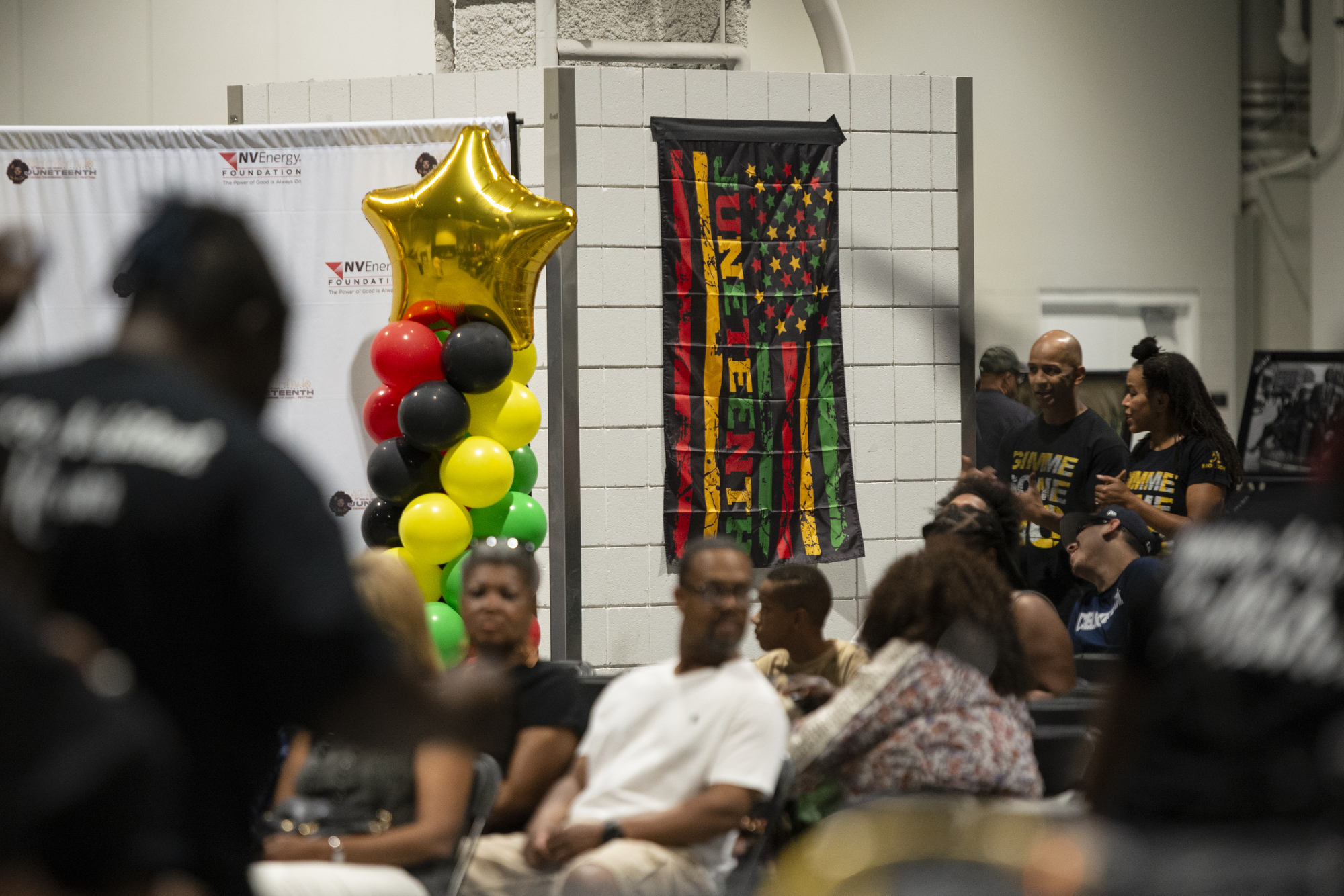Indy Explains: What’s the history behind Juneteenth, Nevada’s newest holiday?

Juneteenth is now a state paid holiday in Nevada. But community leaders say more needs to be done to ensure that people know the gravity of the historic day.
Juneteenth, which takes place on June 19, is considered the longest-running African American holiday and represents freedom from 250 years of what former U.S. slave and author Frederick Douglass called the “bloodied and soul-crushing” institution of slavery. The day marks the historic moment that the last enslaved Africans in rebellious states were freed by soldiers in Galveston, Texas, two years after President Abraham Lincoln signed the Emancipation Proclamation.
“Once you know about it, you celebrate it,” said Assemblywoman Claire Thomas (D-North Las Vegas), who sponsored AB140 in the 2023 session to establish Juneteenth as a paid holiday for state, county and city workers, giving them the day off. The bill was signed into law this month by Republican Gov. Joe Lombardo.
Thomas said Juneteenth commemorates freedom or nationhood similarly to the Fourth of July, stating that she envisions a three-day weekend celebrating “freedom for all.”
Juneteenth, recently dubbed “Freedom Day,” connects people with the liberation, hope and joy that the formerly enslaved, diverse abolitionists and dispersed and broken families felt as brutal slaveholding traditions began to be outlawed in mid-19th century America.
“It's another Independence Day,” Thomas said.
But the stories about enslaved African families have been deliberately obscured, forbidden and suppressed through hundreds of years of slavery, in which reading and writing was grounds for discipline, and decades of Black codes, or legalized discrimination. This left a murky history of U.S. slavery and its abolishment, with a 2018 study by the Teaching Tolerance program of the Southern Poverty Law Center showing that only 8 percent of U.S. high school seniors know that the fight over African slave labor led up to the U.S. Civil War or how the abolition of slavery weakened the South, preventing the nation from permanently splitting apart during Lincoln’s presidency.
This spring, Thomas also introduced AB409, which sought to establish the Juneteenth Education and Economic Commission within the Department of Tourism and Cultural Affairs and create a fund within the treasurer’s office to support endeavors that spread awareness about the history the holiday represents. But it died in a budget committee, with some legislators stating that the efforts were redundant after Nevada lawmakers authorized a Juneteenth Day of recognition in 2011 that requires the governor to issue a proclamation on June 19.
Thomas, as well as Deborah Evans, founder of the Juneteenth Nevada organization who helped present AB140, told The Nevada Independent in an interview that they believe the recognition of the holiday does not go far enough to shine light on the history and that education is needed to ensure that the community understands what they are celebrating.
Thomas said she will immediately get started on a bill draft to reintroduce the Juneteenth commission proposal in 2025.
Evans said the job of the Juneteenth commission would be to share the full history surrounding June 19 and to correct misinformation about slavery and its abolishment through cultural programming and educational curriculum.
“We do not say that Juneteenth is the last day of [slavery],” Evans said. “That's another thing we're correcting. It was selected to represent the last days of [being property in America].”
Black people’s emancipation in America
It’s estimated that at least 500,000 people were untouched by Lincoln’s proclamation because they were the property of slaveholders in border states that did not rebel such as Maryland, Kentucky, Missouri and West Virginia.
When Lincoln was elected in 1860, there were more than 4 million enslaved Africans relegated to the status of property to white men in the U.S. A month later, South Carolina seceded from the Union and was followed by Southern states — Florida, Mississippi, Georgia, Alabama, Texas, Tennessee, North Carolina, Virginia, Arkansas and Louisiana — forming the Confederacy and appointing Jefferson Davis as acting president by early 1861.
According to CNN’s documentary Lincoln: Divided We Stand, the motivation behind the secession stemmed from desires to extend slave labor to west of Texas as the nation expanded, which historians say Lincoln opposed.
“What Lincoln wrote was a presidential report, but it was not a law,” Evans said about the Emancipation Proclamation. “It was just a presidential documentation of what he says should have been free.”
In September 1862, nearly two years into the U.S. Civil War, Lincoln issued a Preliminary Emancipation Proclamation that gave the Confederate Army 100 days to end the war, or he would declare every slave in rebellious states free. The document, which was more of a warning, stated that Southern states could retain slave labor if they stopped rebelling.
According to historians, Lincoln’s decision to emancipate U.S. slaves was heavily weighed on politics such as winning and ending the war, protecting democracy and weakening the states that had seceded months into his presidency. By Dec. 31,1862, no states had laid down arms and on Jan. 1, 1863, Lincoln fulfilled his promise and released the Emancipation Proclamation to free slaves living in rebel territory and invite them to join the Union army.
“People don't know that there were Black soldiers in Galveston, Texas, and how many they had,” Evans said. “They’re thinking white folks saved them, they’re lazy, they did nothing for themselves.”
The Juneteenth Legacy Project found that four regiments of the U.S. Colored Troops arrived at Galveston Bay on June 18, 1865. According to the African American Civil War Memorial in Washington D.C., there were 209,145 formerly enslaved men who joined the Union in response to Lincoln’s proclamation.
Evans said key provisions in the proclamation, which deemed enslaved people in the South free from bondage, were not solidified nationally until the 13th Amendment was ratified when three quarters of states signed on by Dec. 6, 1865.
“And a year after that, in June of 1866, there were five Indian nations that signed treaties to release their slaves,” she said.
“The Five Civilized Tribes” of Oklahoma — the Cherokee, Choctaw, Chickasaw, Muscogee (Creek) and Seminole nations — agreed to Reconstruction Treaties with the U.S., which included differing agreements to abolish slavery in Indian territories, such as granting $300,000 in a trust to the Choctaw and Chickasaw tribe in exchange for granting “freedmen” citizenship on their lands. Other agreements included giving freedmen land and citizenship.
Freedmen was the political status of formerly enslaved Africans who did not gain U.S. citizenship until the ratification of the 14th Amendment in July 1868.
“When they released their slaves, neither the Native Americans nor the U.S. government wanted to have anything to do with the free people,” Evans said. “So they founded 100 Black towns in the western territory, primarily in Oklahoma and there are 12 still in existence … with their roots in 1865, 1866.”
The state of Juneteenth in Nevada
For the past 22 years, Southern Nevadans have celebrated a Juneteenth Jubilee Festival on the west side of Las Vegas that has grown and is now held inside the downtown World Market Center. In Reno, residents have attended the Black Cultural Awareness Society’s Juneteenth Festival for 35 years. Other events in the state include Juneteenth Nevada’s Miss Juneteenth Scholarship Program and the Juneteenth African American Academics and Art Camp.
Thomas said she envisions an expansion of Juneteenth programming, with festivities that attract local families and people from all over the globe.
“People come here just to be here,” she said of Las Vegas. “So, could you imagine a three-day holiday celebrating freedom for all? That's going to be just amazing.”
She said she’s willing to make some changes to her Juneteenth education bill, to which the Nevada Department of Tourism and Cultural Affairs attached a $1.6 million dollar fiscal note in the 2023 legislative session, by limiting the amount of staff needed for the commission. That change could keep the initial cost around $400,000.
The Tourism and Cultural Affairs department supports yearly cultural events such as Lunar New Year or Day of the Dead and is anticipating future Juneteenth Day programming could include art and museum exhibitions and other festivities reflecting the history.
“This is still relatively new for us to focus on and find the contacts in the community to develop [Juneteenth] programming that people want to see,” said Myron Freedman, administrator of the Nevada Museums and History, in an interview earlier this month.
Brenda Scolari, the executive director of the Nevada Department of Tourism and Cultural Affairs, said her job involves placemaking through economic and cultural health, or supporting people’s personal culture and experiences.
Freedman said his focus at the museum is mainly Nevada heritage, a state that signed onto the Union in 1864 during the Civil War.
“Our focus on Nevada heritage is to make sure we're collecting across a broad spectrum of stories and people and cultures,” he said. “These [efforts] are based on audiences that we know are out there, and that come to our museums and so we develop programs to serve them.”
